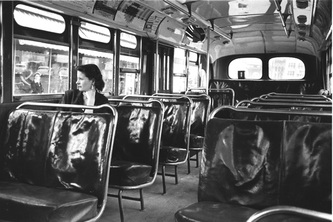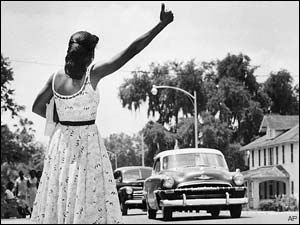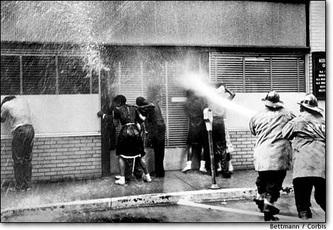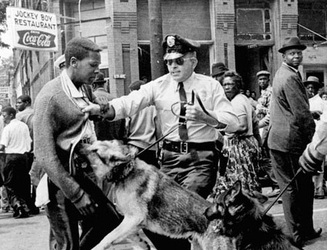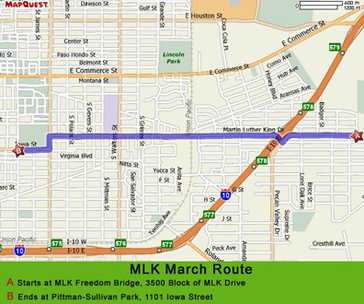Nonviolent Social Reform
1929-1968

Born on January 15, 1929, into a highly segregated community with solid roots of racial inequality, Dr. Martin Luther King Jr. experienced iniquity throughout his life. Growing up in the biased ingrained south, in Atlanta, Georgia, King shared the lack of hope for change as all other minorities in society. It was not until attending Morehouse College, Crozer Theological Seminary, and Boston University that he became fully aware of historic philosophers and leaders who incontrovertibly generated optimism in King for potential change.
First introduced to the works of Henry David Thoreau, King familiarized himself with the concept that men have the right to resist biased laws. However, he doubted the success of the seemingly impractical nonviolence methods until further studies. Clearly evident here, King demonstrates reassurance, “as I delved deeper into the philosophy of Gandhi, my skepticism concerning the power of love gradually diminished, and I came to see for the first time that the Christian doctrine of love, operating through the Gandhian method of nonviolence, is one of the most potent weapons available to an oppressed people in their struggle for freedom."
Studying the techniques of Gandhi guided the thoughts and actions of King throughout his fight for civil rights in the 1950s and 1960s. The magnificence of civil disobedience is how the oppressors begin questioning their own morals and the impartiality of their government’s laws. On a more obvious note, fewer lives are lost through peaceful resistance.
Boycotting, a strategy inspired by Mahatma Gandhi and instigated by the actions Rosa Parks, was successfully utilized by Dr. King. In 1955 Rosa Parks, an African American seamstress living in Montgomery, Alabama, refused to give up her seat to a white person on a crowded bus. As a result, police arrested Rosa immediately for disobeying segregation laws. Soon after, the Montgomery Improvement Association, with Dr. King elected as their leader, organized a bus boycott across Montgomery. Most African Americans drove their own cars, biked, or walked instead of taking the bus. They even cleverly launched a car pool system charging 10 cents per ride for all African Americans. As expected, upset policemen found absurd reasons to arrest African Americans in effort to cease this boycott, though their attempts proved fruitless. Lasting 381 effective days, the bus boycott ended with the desegregation of the buses in 1956.
First introduced to the works of Henry David Thoreau, King familiarized himself with the concept that men have the right to resist biased laws. However, he doubted the success of the seemingly impractical nonviolence methods until further studies. Clearly evident here, King demonstrates reassurance, “as I delved deeper into the philosophy of Gandhi, my skepticism concerning the power of love gradually diminished, and I came to see for the first time that the Christian doctrine of love, operating through the Gandhian method of nonviolence, is one of the most potent weapons available to an oppressed people in their struggle for freedom."
Studying the techniques of Gandhi guided the thoughts and actions of King throughout his fight for civil rights in the 1950s and 1960s. The magnificence of civil disobedience is how the oppressors begin questioning their own morals and the impartiality of their government’s laws. On a more obvious note, fewer lives are lost through peaceful resistance.
Boycotting, a strategy inspired by Mahatma Gandhi and instigated by the actions Rosa Parks, was successfully utilized by Dr. King. In 1955 Rosa Parks, an African American seamstress living in Montgomery, Alabama, refused to give up her seat to a white person on a crowded bus. As a result, police arrested Rosa immediately for disobeying segregation laws. Soon after, the Montgomery Improvement Association, with Dr. King elected as their leader, organized a bus boycott across Montgomery. Most African Americans drove their own cars, biked, or walked instead of taking the bus. They even cleverly launched a car pool system charging 10 cents per ride for all African Americans. As expected, upset policemen found absurd reasons to arrest African Americans in effort to cease this boycott, though their attempts proved fruitless. Lasting 381 effective days, the bus boycott ended with the desegregation of the buses in 1956.
Most famous of the marches King coordinated, the Birmingham March, occurred throughout April and May of 1963. This protest consisted of three individual steps. First on April 4, African Americans began boycotting businesses and arranging sit-ins. Protests occurred everyday on city hall starting April 6. Lastly and most effective, on May 2 around one thousand African American children marched in protest, coining the name, “the children’s crusade.” Adults during this particular time were hesitant to spend jail time. However, arrested children spending jail time unexpectedly stirred the hearts of the nation. Protesters, as well as the children, were brutally attacked physically with fire hoses, dogs, and cattle prods. The media, capturing these wicked acts, published them to the nation. Because of the cruel response of the police, this event is identified as the launching point of the civil rights movement. Resentment from African Americans reached an all time high, further strengthening their motivation for social reform. This additionally caught the attention of the government, leading to the Civil Rights Act of 1964, illegalizing public segregation and discrimination of employees and unions.
The tactics Martin Luther King Jr. adopted from Gandhi proved undeniably beneficial to the success of the social reform campaign. In the end, African Americans gained equal rights. However, the key to success predominantly belongs to the well-known leader who possessed the remarkable and indestructible valor to conduct protests as a minority, putting himself at high risk. Likewise, we cannot forget the fearless supporters of the civil rights movement, for their contributions did not lack courage but fed on their own persecution. "It takes more courage to take a blow than give one.” Mahatma Gandhiji
Bibliography
Blakeley, Gregg. “The Formative Influences on Dr. Martin Luther King, Jr.” Peace Magazine Spring 2001: n. pag. Peacemagazine.org. Web. 3 Apr. 2011.
“A Changing Movement, 1954-1975 (Visual).” American History. ABC-CLIO. N.p., n.d. Web. 3 Apr. 2011.
“Martin Luther King Jr.” World History: The Modern Era. N.p., n.d. Web. 3 Apr. 2011.
McFarland, Robert E. “Birmingham March.” Salem History. N.p., n.d. Web. 4 Apr. 2011.
“Remembering Martin Luther King Jr.: Background.” American History. ABC-CLIO. N.p., n.d. Web. 3 Apr. 2011.
Russell, Rose M. “Martin Luther King Jr.” Salem History. N.p., n.d. Web. 3 Apr. 2011.
“The Life and Words of Martin Luther King, Jr.” Scholastic. N.p., n.d. Web. 4 Apr. 2011.
“A Changing Movement, 1954-1975 (Visual).” American History. ABC-CLIO. N.p., n.d. Web. 3 Apr. 2011.
“Martin Luther King Jr.” World History: The Modern Era. N.p., n.d. Web. 3 Apr. 2011.
McFarland, Robert E. “Birmingham March.” Salem History. N.p., n.d. Web. 4 Apr. 2011.
“Remembering Martin Luther King Jr.: Background.” American History. ABC-CLIO. N.p., n.d. Web. 3 Apr. 2011.
Russell, Rose M. “Martin Luther King Jr.” Salem History. N.p., n.d. Web. 3 Apr. 2011.
“The Life and Words of Martin Luther King, Jr.” Scholastic. N.p., n.d. Web. 4 Apr. 2011.
